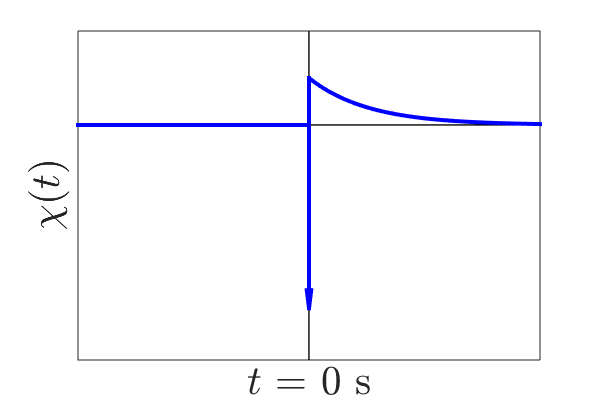Impulse Response
Purpose
The sphere’s time-dependent response to an arbitrary excitation is represented by its impulse response. Here, analytic expressions for the sphere’s impulse response are presented for a permeable and a non-permeable sphere.
Introduction

Fig. 142 Representation of the impulse response for the excitation of a conductive and permeable sphere.
According to our general formulation, the induced dipole moment \(m(t)\) characterizing the sphere is defined by a convolution:
where \(R\) is the sphere’s radius, \(\chi (t)\) represents the sphere’s impulse response and \(h_0 (t)\) represents the inducing field. By definition, \(\chi (t)\) is the inverse Fourier transform of the sphere’s frequency-dependent excitation factor ([Wai51]):
The general shape of the impulse response for a conductive and magnetically permeable sphere is shown in Fig. 142. At \(t<0\), the impulse response is zero. This indicates that the sphere’s TEM response is causal. As a result, an convolution with the sphere’s impulse response can be expressed as an integral from 0 to \(\infty\):
Ultimately, the sphere’s TEM response depends on the scaling of the delta function which occurs at \(t=0\) and the decay which is observed for \(t>0\). Below, analytic expressions for the impulse response for permeable and non-permeable sphere’s are presented. Derivations used to obtain these expressions are found in the following section.
Conductive Sphere
For a conductive and non-permeable (\(\mu = \mu_0\)) sphere, the impulse response is given by ([WS69]):
where \(\delta (t)\) is the Dirac delta function, \(u(t)\) is the unit-step function and:
Conductive and Permeable Sphere
For a conductive and permeable sphere, the impulse response is given by ([WS69]):
where:
Coefficients \(\xi_n\) within the sum are defined by:
From Wait and Spies ([WS69]), coefficients \(\xi_n\) are spaced roughly \(\pi\) apart with:
The value of each coefficient may be found iteratively using very few iterations (< 10) according to: